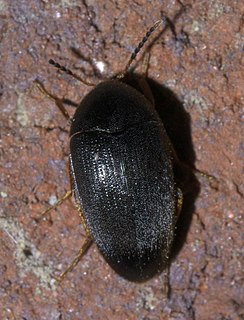
Eucinetidae is a family of beetles, notable for their large coxal plates that cover much of the first ventrite of the abdomen, sometimes called plate-thigh beetles. The family is small for beetles, with about 50 species in 11 genera, but are found worldwide.

Talitrus saltator, a species of sand hopper, is a common amphipod crustacean of sandy coasts around Europe. The animal's typical "hopping" movement gives it its common name, and is produced by a flexion of the abdomen. In order to do this, it must stand on its legs and suddenly extend its abdomen out from under its body. It can thus leap several inches into the air, although without any control over its direction. A great deal of scientific research has been carried out on the animal, to determine the environmental cues which it uses to control its behavior.

Elmidae, commonly known as riffle beetles, is a family of beetles in the superfamily Byrrhoidea described by John Curtis in 1830. Both adults and larvae are usually aquatic, living under rocks in fast-flowing shallow areas of streams, such as riffles, feeding on algae and biofilms. There are more than 150 genera and 1,500 described species in Elmidae. The oldest record of the group is Cretohypsilara from the Cenomanian aged Burmese amber.
Nycteus punctulatus is a species of plate-thigh beetle in the family Eucinetidae. It is found in North America.
Nycteus is a genus of plate-thigh beetles in the family Eucinetidae. There are about 11 described species in Nycteus.
Pedetontus saltator, the jumping bristletail, is a species of jumping bristletail in the family Machilidae. It is found in North America.
Tohlezkus inexpectus is a species of plate-thigh beetle in the family Eucinetidae. It is found in North America.
Tohlezkus is a genus of plate-thigh beetles in the family Eucinetidae. There are at least three described species in Tohlezkus.
Euscaphurus is a genus of plate-thigh beetles in the family Eucinetidae. There are at least three described species in Euscaphurus.
Nycteus oviformis is a species of plate-thigh beetle in the family Eucinetidae. It is found in North America.
Nycteus infumatus is a species of plate-thigh beetle in the family Eucinetidae. It is found in North America.
Nycteus testaceus is a species of plate-thigh beetle in the family Eucinetidae. It is found in North America.
Eucinetus strigosus is a species of plate-thigh beetle in the family Eucinetidae. It is found in North America.

Eucinetus is a genus of plate-thigh beetles in the family Eucinetidae. There are at least four described species in Eucinetus.

Cissites is a genus of blister beetles in the family Meloidae. There are at least four described species in Cissites.

Eucinetus morio is a species of plate-thigh beetle in the family Eucinetidae. It is found in North America.

Eucinetus terminalis is a species of plate-thigh beetle in the family Eucinetidae. It is found in North America.
Euscaphurus spinipes is a species of plate-thigh beetle in the family Eucinetidae. It is found in North America.
Ormiscus saltator is a species of fungus weevil in the beetle family Anthribidae. It is found in North America.
Nycteus falsus is a species of plate-thigh beetle in the family Eucinetidae. It is found in Central America and North America.





